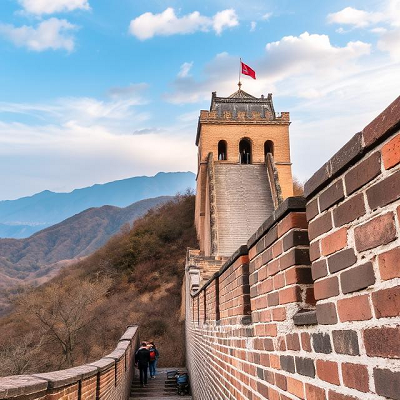The Great Wall of China, one of the most awe-inspiring wonders of the world, stretches over 13,000 miles across northern China. Originally built to protect ancient Chinese states and empires from invasions, this remarkable feat of engineering is not just a wall, but a complex system of watchtowers, fortresses, and barriers that spans across mountains, deserts, and plains. Visiting the Great Wall offers an unparalleled opportunity to step back in time and experience the scale and grandeur of one of humanity’s greatest architectural achievements.
There are several sections of the Great Wall that tourists can visit, each offering a unique experience. The most popular and well-preserved sections are located near Beijing, such as Badaling and Mutianyu. These sections are easily accessible, with cable cars and modern amenities making the journey comfortable for tourists. At Badaling, you can walk along the Wall while taking in sweeping views of the surrounding mountains and valleys. Mutianyu, slightly further from Beijing, offers a more serene atmosphere, with fewer crowds and a cable car that takes you to one of the highest points on the Wall.
For those seeking a more authentic experience, visiting sections like Jinshanling or Simatai is highly recommended. These parts of the Wall are less restored, offering a more rugged and adventurous experience. Hikers can traverse watchtowers, climb steep steps, and experience the Wall’s original construction. While the terrain can be challenging, the sense of accomplishment and the panoramic views make the effort worthwhile. These less-traveled areas provide a glimpse into the Wall’s true historical and natural beauty, far from the tourist crowds.
The history behind the Great Wall is as fascinating as the structure itself. Construction began in the 7th century BC and continued for centuries under various dynasties, including the Qin and Ming Dynasties. The Wall was built by millions of laborers, soldiers, and prisoners, who faced extreme conditions. As you walk along the Wall, you’ll pass through ancient watchtowers, which once housed soldiers keeping a lookout for invaders. Many of these towers are still standing today, serving as a testament to the ingenuity and perseverance of the people who built them.
Visiting the Great Wall also offers an opportunity to immerse yourself in China’s rich cultural history. Several nearby museums, such as the Great Wall Museum in Beijing, provide in-depth exhibits on the history and significance of the Wall. The museum showcases artifacts, ancient relics, and detailed explanations of how the Wall was constructed, providing context and helping visitors understand the true significance of the Wall as a defense mechanism, a symbol of Chinese strength, and a feat of engineering.
A visit to the Great Wall is not just about seeing a famous landmark; it’s about experiencing the connection between nature, history, and human ingenuity. Whether you are hiking up steep steps, marveling at the panoramic views, or simply reflecting on the Wall’s long and storied past, it’s an unforgettable journey. The Great Wall is a symbol of China’s enduring culture, strength, and resilience, and a must-see destination for any traveler to China.

